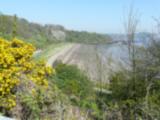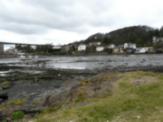Winter Birds

The Forth Estuary is a vital wintering area for many species of duck, wader and other sea birds. North Queensferry makes its contribution by providing a haven for some of these birds around the coast and in West Bay and Port Laing. The view point at Carlingnose is sufficiently high above the sea to give an excellent panorama of the islands and Inches dotting the estuary and is also a good spot for scanning the sea for the wintering birds. Perhaps the most exotic regular visitor is the red-throated diver.
Though it belies its name at this time of year its streamlined shape, pale underparts and up-turned bill pick it out from the darker cormorants and shags which are resident birds with the same feeding strategy of fishing below water. Shags often jump out of the water as they dive, cormorants do a vigorous dive, while the diver glides under almost unnoticed.

The resident eiders are joined in winter by flocks of goldeneyes and red-breasted mergansers. All three species feed by diving, the eiders usually to pick crabs from the bottom and the others catching fish. These ducks are also occasionally joined by goosanders, scaups, velvet and common scoters and long-tailed ducks. Other parts of the Estuary such as Musselburgh, Aberlady, Kinghorn and Leven are more favoured by these ducks, but it is always a good idea to check out anything you see on the water. Great-crested grebes and little grebes also winter on the coastal waters. Several years ago there were about 125 great-crested grebes off Port Laing , but that was exceptional. Little grebes can often be seen from the coastal path between Carlingnose and Cruickness Point in winter.
Guillemots and razorbills also use the coasts as feeding areas in winter and there have also been 2 or 3 sightings of black guillemots. After strong northerly winds in the North Sea, it is also worth checking for that rare visitor from the Arctic- the little auk. About 60 were seen in October 2007.
Most of the wintering waders can best be seen on a rising tide in West Bay. Between 30 and 50 redshanks, perhaps a dozen curlews and 30 or so oystercatchers feed on the mud or amongst the seaweed covered rocks. At high tide they roost on the breakwaters or rocky islands such as Long Craig under the Road Bridge. A small flock of turnstone also feeds amongst the seaweed in West Bay. The highlight of recent years was during the 2000-2001 winter when a flock of about 300 dunlin used to arrive in West Bay as the tide advanced. Such numbers haven’t been seen recently, but a few dunlin can often be seen with the redshanks in West Bay. Other waders which have paid fleeting visits to West Bay in winter have included knot, bar-tailed godwit, golden plover and lapwing.
Winter is also a time to see the resident birds around the village as well as visitors from the continent. Redwings and fieldfares often feed on the fruit on the hawthorn, cotoneaster and dog rose along the coastal path in early winter. These thrushes, as well as blackbirds and song thrushes, fly in from Northern Europe to escape the rigours of winter and join up with the locals as they busily and noisily replenish their reserves before moving on as the supplies dry up. What the locals think of their noisy cousins is anyone’s guess. Other common resident species have also to survive the winter and can often be seen in mixed flocks searching the trees and bushes for invertebrate prey. Winter is a good time to see coal, blue and great tits as well as long-tailed tits, robins, wrens and dunnocks.
 Our resident goldcrests are also joined by continental birds. It is amazing to realise that Europe’s smallest bird weighing about 5 grams can make a flight across the North Sea, but occasionally thousands of them are blown across and find food and shelter along the East coast of the UK. Another winter visitor which has only recently started appearing is the blackcap. This is a common summer visitor, but small numbers now arrive from Holland and Germany in the winter. One or two are seen fairly regularly around the village.
Our resident goldcrests are also joined by continental birds. It is amazing to realise that Europe’s smallest bird weighing about 5 grams can make a flight across the North Sea, but occasionally thousands of them are blown across and find food and shelter along the East coast of the UK. Another winter visitor which has only recently started appearing is the blackcap. This is a common summer visitor, but small numbers now arrive from Holland and Germany in the winter. One or two are seen fairly regularly around the village.
Other small birds to be seen are the various finches, house sparrows and starlings. The sparrows like the ivy on the trees and older buildings around the village and can be very noisy when they are discussing the latest good feeding areas and the local gossip. The finches can be found where there is good feeding and there is often a small flock of starlings on or near the roof of the school by the railway station. Feral pigeons share the school roof with the starlings and both have to be wary of the local sparrowhawks and the peregrine falcons which occasionally fly over. If you are very lucky you may see one of the falcons perched on the Rail Bridge waiting for the feral pigeons to fly off as a train comes over the bridge.
Crows and magpies are common in North Queensferry, whilst their close relatives jackdaws and rooks are mainly seen flying over in their journeys across The Forth. More recently at least 2 ravens have been seen regularly over the village and near Cruickness quarry.
 All in all North Queensferry is a good place for birds in winter. The common species are around in good numbers and the sea and the mud in West Bay provide good feeding for some of the more exotic and unusual birds which choose to winter here. This is not a completely comprehensive account of the birds you could see during a winter visit to North Queensferry, but I hope it has given you a good idea of what you might see. Have a good walk around the village and along the coastal path towards Cruickness Point and you will probably see at least 30 different species.
All in all North Queensferry is a good place for birds in winter. The common species are around in good numbers and the sea and the mud in West Bay provide good feeding for some of the more exotic and unusual birds which choose to winter here. This is not a completely comprehensive account of the birds you could see during a winter visit to North Queensferry, but I hope it has given you a good idea of what you might see. Have a good walk around the village and along the coastal path towards Cruickness Point and you will probably see at least 30 different species.
Enjoy your visit and good luck with the bird spotting.